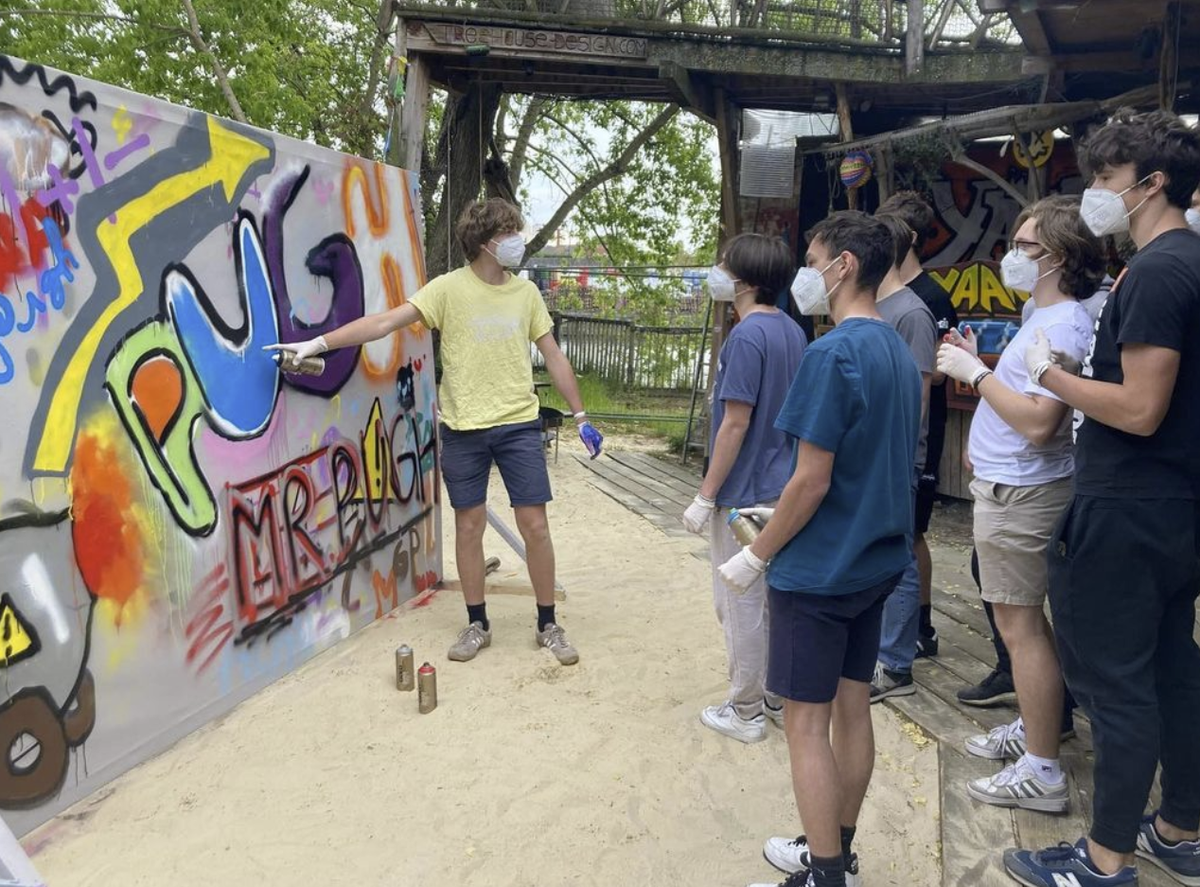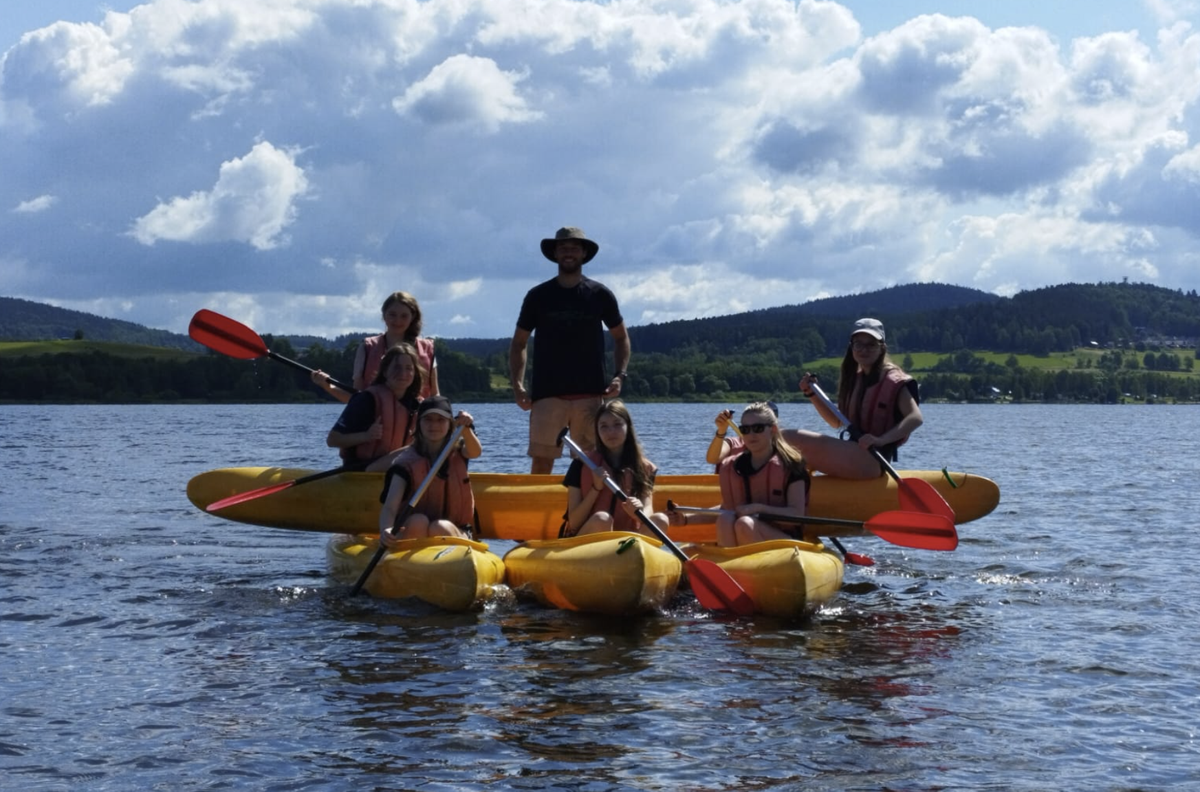Trips/Výlety
Year 5 trip to the Netherlands

Trips/Výlety
Year 5 trip to the Netherlands


On the 15th of May, Year 3 German students embarked on a 5-day trip to Berlin to explore its cultural, political, and historical significance, and also to practise some German. During our stay, we got a unique perspective of the city, that couldn’t quite catch a break during the past century, through several different museums, exhibitions and other experiences.


On the first full day in Berlin, we visited the DDR museum, which outlined many different aspects of living in East Germany, from seeing how people lived and dressed to reading about the various institutions of the DDR to (most importantly), getting to drive the iconic Trabant (only as a simulator, of course). Next, the Year 3 students went on a guided tour of the side of Berlin that is almost invisible to the naked eye, namely its street art sphere. The tour guide was someone who definitely embodied the entire alternative nature of Berlin and would take our year across different parts of Berlin. He would show us a seemingly random and unremarkable part of the city and suddenly make it feel full of history and significance to the local community. For many of us, it changed our whole perspective of Berlin. This was followed by a graffiti workshop in the YAAM (Young African Art Market), where we brainstormed graffiti ideas, learned how to use spray cans and different techniques, and ended up with some creative artwork.


Our visits to the Computerspiel Museum and the German Spy Museum were more entertainment-oriented but still had some interesting pieces of history in their respective fields. In the Computerspiel Museum, we were thrown back into different eras of video games, from the arcades to the days of Atari, Nintendo, and PlayStation. In the German Spy Museum, we could test the strength of our passwords, try a lie detector test, traverse between laser beams, see a small James Bond exhibition, and read something about the spies of the Cold War on both sides.
Our year also visited the Reichstag building, which was a very good insight into the function and system of parliament of one of the most significant European countries. It was also a fascinating look into the history of the building, which had, much like all of Berlin, gone through so much. Our tour of the Olympiastadion, where Jesse Owens proved the Nazi theories of race to be completely false in the 1936 Olympics, was an intriguing lesson on how to not forget but also manage to move on and was a treat for all the football fans in our year. The Topography of Terror exhibition was an almost disturbingly detailed look into the actions of the SS and the Third Reich's methods of maintaining power. Finally, on our last day, we visited the Berlin Wall memorial, where we could see where and how the wall stood and its history, including the many successful and unsuccessful efforts to cross the border between the two halves of the city.


The impression that most of us got after visiting Berlin is that it is a city that will always be a bit odd, be it because of the people's often alternative lifestyle, the mix of the old and new, remembering but moving on, its ordered but also chaotic nature, the echoes of the East and West division—it will forever be somehow different.
Tadeáš J. Vácha Y3


15. května se studenti němčiny z 3. ročníku vydali na 5denní výlet do Berlína, aby zde prozkoumali kulturní, politický a historický význam města a procvičili si němčinu. Během pobytu jsme díky několika různým muzeím, výstavám a dalším zážitkům získali jedinečnou perspektivu města, které si v minulém století nemohlo moc odpočinout.
První den v Berlíně jsme navštívili muzeum NDR, které nastínilo mnoho různých aspektů života ve východním Německu, od způsobu života a oblékání, přes četbu o různých institucích NDR až po jízdu ikonickým Trabantem (což bylo to je nejdůležitější) - samozřejmě pouze na simulátoru. Dále jsme se vydali na komentovanou prohlídku té části Berlína, která je pouhým okem téměř neviditelná, a to pouličního umění. Náš průvodce rozhodně ztělesňoval celou alternativní povahu Berlína a vzal nás napříč různými částmi města. Ukázal nám zdánlivě nahodilou a nepozoruhodnou část města, ale uměl ji rázem proměnit v oblast plnou historie a významu pro místní komunitu. Pro mnohé z nás to změnilo celý náš pohled na Berlín. Následoval graffiti workshop na trhu YAAM (Young African Art Market), kde jsme probírali nápady na graffiti, naučili se používat spreje a různé techniky a vytvořili jsme pár kreativních uměleckých děl.


Naše návštěvy v muzeích Computerspiel Museum a German Spy Museum byly zaměřeny spíše na zábavu, ale přesto ve svých specializacích přinesly zajímavé kousky historie. V Computerspiel Museum jsme byli vrženi zpět do různých epoch videoher, od arkád až po časy Atari, Nintendo a PlayStation. Ve špionážním muzeu jsme si mohli vyzkoušet sílu našich hesel, otestovat se na detektoru lži, procházet mezi laserovými paprsky, prohlédnout si malou výstavu Jamese Bonda a přečíst si něco o špionech studené války na obou stranách.
Později jsme navštívili i budovu Říšského sněmu, která nám poskytla dobrý náhled do funkce a systému parlamentu jedné z nejvýznamnějších evropských zemí. Získali jsme i fascinující pohled do historie budovy, která toho, stejně jako celý Berlín, tolik prožila. Naše prohlídka Olympiastadionu, kde Jesse Owens na olympijských hrách v roce 1936 dokázal, že nacistické teorie o rase jsou zcela mylné, byla zajímavou lekcí o tom, jak nezapomenout, ale také dokázat jít dál, a byla lahůdkou pro všechny fotbalové fanoušky z našich řad. Výstava Topografie teroru byla téměř znepokojivě detailním pohledem do akcí SS a metod Třetí říše, jak si udržet moc. Nakonec jsme poslední den navštívili památník Berlínské zdi, kde jsme mohli vidět, kde a jak zeď stála a dozvědět se o její historii, včetně mnoha úspěšných i neúspěšných pokusů o překročení hranice mezi dvěma polovinami města.
Většina z nás po návštěvě Berlína nabyla dojmu, že je to město, které bude vždy trochu zvláštní, ať už kvůli často alternativnímu životnímu stylu lidí, směsi starého a nového, vzpomínání, ale i posunu vpřed, jeho uspořádané, avšak i chaotické povahy či ozvěny rozdělení Východu a Západu. Toto město bude navždy tak nějak jiné.
Tadeáš J. Vácha Y3


Most of the Y3 and Y4 Spanish students went on a Spanish trip to Valencia in May, a trip we will remember for a very long time. Valencia is a beautiful and modern city, and we had the opportunity to explore it to the fullest. We went on several tours: of the city centre, the city of the arts and sciences, la Ciudad de las Artes y las Ciencias, and we also explored the city on our own during long free time periods. Valencia didn’t only welcome us with its sunny and warm weather but also its unique culture. We got to eat many traditional Spanish foods, such as tapas, paella, and more, and we even had the opportunity to make our own paella which was one of my favourite experiences on this trip.


Valencia is located close to the sea, and after finding out we could not use public transport, we had no other choice but to walk there. It was a long walk, but the joy we felt when we finally saw the waves dancing in the distance made it all worth it. In addition to going to the beach, we also went on a catamaran and got to see the sunset from the sea, which was a magical experience I will certainly never forget.
It was, of course, a Spanish trip, meaning on top of learning about the city and its culture, we also got to practise our Spanish every day. It was completely different from speaking in Spanish in the class, as it was a bit more stressful talking to a native speaker, especially with their often rapid speaking pace. Everyone in Valencia was really kind, though, and loved to chat with us about where we were from and what we were doing in Valencia.


There was so much I loved about Valencia and this trip, and it would take a few thousand words to express how amazing this trip was. I truly hope I will get to visit Valencia again in the future, and I hope that everyone who goes on the Spanish trip next year will also have such an incredible time.
¡Muchas gracias Valencia!
Amélie Fišerová, Year 3


Většina studentů španělštiny ze 3. a 4. ročníku se v květnu vydala na výlet do Valencie, na který budeme ještě dlouho vzpomínat. Valencie je krásné a moderní město a my jsme měli možnost ho prozkoumat naplno. Absolvovali jsme několik prohlídek, ať už centra města, města umění a věd, la Ciudad de las Artes y las Ciencias a také jsme město prozkoumávali sami během volného programu. Valencie nás přivítala nejen slunečným a teplým počasím, ale také jedinečnou kulturou. Mohli jsme ochutnat mnoho tradičních španělských jídel, jako jsou tapas, paella a další, a dokonce jsme měli příležitost vyrobit si vlastní paellu, což byl jeden z nejlepších zážitků tohoto výletu.
Valencie leží blízko moře a po zjištění, že nemůžeme využít MHD, nám nezbylo nic jiného, než tam jít pěšky. Byla to dlouhá procházka, ale ta radost, kterou jsme pocítili, když jsme konečně v dálce viděli vlny tančit, stála za to. Kromě pláže jsme jeli i na katamaránu a viděli západ slunce z moře, což byl kouzelný zážitek, na který určitě nikdy nezapomenu.


Byl to výlet španělštinářů, což znamená, že kromě poznávání města a jeho kultury jsme si také každý den procvičovali španělštinu. Bylo to úplně jiné než mluvit španělsky ve třídě, protože bylo trochu stresující mluvit s rodilými mluvčími, zvláště s jejich často rychlým tempem řeči. Všichni ve Valencii byli ale opravdu laskaví a rádi si s námi povídali o tom, odkud jsme a co ve Valencii děláme.
Na Valencii a na celém výletu se mi toho líbilo tolik, že bych musela napsat několik tisíc slov, abych vyjádřila, jak úžasný tento výlet byl. Opravdu doufám, že se v budoucnu znovu do Valencie podívám a že každý, kdo se příští rok vydá na tento výlet, si ho také neskutečně užije, tak jako já.
¡Muchas gracias Valencia!
Amélie Fišerová, 3. ročník




YEAR 1/1. ROČNÍK - Karlštejn area












YEAR 2/2. ROČNÍK - CCC (camping, cycling, canoeing) trip to South Bohemia










YEAR 3/3. ROČNÍK - Jeseníky mountains








YEAR 4/4. ROČNÍK - Oxford Trip








YEAR 5/5. ROČNÍK - Dutch Universities Trip










Day trips in Prague/Výlet po Praze
Year 1/1. ročník - Anežský klášter




Year 3/3. ročník - Hradčany





